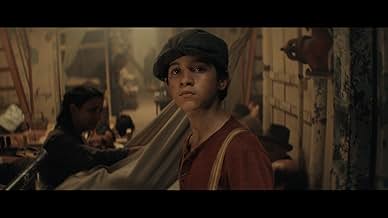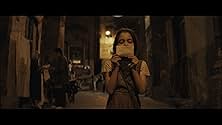Sigue a dos niños napolitanos en su viaje a Nueva York para escapar de la pobreza italiana de principios de la posguerra.Sigue a dos niños napolitanos en su viaje a Nueva York para escapar de la pobreza italiana de principios de la posguerra.Sigue a dos niños napolitanos en su viaje a Nueva York para escapar de la pobreza italiana de principios de la posguerra.
- Dirección
- Guionistas
- Elenco
- Premios
- 4 nominaciones en total
- Dirección
- Guionistas
- Todo el elenco y el equipo
- Producción, taquilla y más en IMDbPro
Opinión destacada
Io non ho paura (2003) remains a personal favorite, and Gabriele Salvatores is a director I've admired ever since seeing it. In the landscape of Italian cinema, whose glory days seem long past, he remains one of the few names still commanding respect.
The film generated buzz even before its release. This anticipation stemmed from its screenplay, based on a draft co-written by Federico Fellini and Tullio Pinelli-Fellini's longtime collaborator on masterpieces like La Strada (1954) and La Dolce Vita (1960). Dating back to the mid-1940s, the draft was discovered and subsequently published in 2006.
The draft was found by Pinelli himself in a trunk full of odds and ends. Salvatores remarked:
"'To possess a story written by Federico Fellini and Tullio Pinelli, about which almost nothing was known, was in itself a magnificent thing... How could I remain indifferent to something so compelling? It's a story dated to the late 1940s, inspired by a true event, and told like a fable. Moreover, it corresponds to a transitional period in Italian cinema: between neorealism, Italian comedy, and the first experiments with a more fantastical cinema.'"
Although the screenplay is based on a story bearing Fellini's signature, there's little in the film's narrative that could be described as 'Felliniesque'.
While the fact that the story, largely set in New York City's Manhattan, was filmed in Italian studios-making Manhattan look conspicuously like a set-occasionally pulls the viewer out of the reality, Antonio Guerra, playing the protagonist Carmine, manages to win the audience back. 2024 was quite a banner year for young talent; that trend seems poised to continue in 2025.
The sporadic English dialogue interspersed throughout the predominantly Italian film served as a potent reminder of just how beautiful the Italian language is. Because even when spoken by the Italian actors themselves, the English simply sounds coarse following the Italian.
Regrettably, the film also suffers from pacing issues. Roughly divided into three parts-the escape from Italy, the sea voyage, and New York-the film features several anachronistic and jarring details that detract, from the music used in the Manhattan scenes to the inclusion of the 'Women's Liberation' slogan, an emblem that would only emerge two decades after the film's 1940s setting.
Furthermore, the film could easily have been trimmed by about 25 minutes.
Gabriele Salvatores presents us with a Federico Fellini story that might otherwise have been lost to time. Despite its flaws, this undertaking is itself a commendable effort.
The film generated buzz even before its release. This anticipation stemmed from its screenplay, based on a draft co-written by Federico Fellini and Tullio Pinelli-Fellini's longtime collaborator on masterpieces like La Strada (1954) and La Dolce Vita (1960). Dating back to the mid-1940s, the draft was discovered and subsequently published in 2006.
The draft was found by Pinelli himself in a trunk full of odds and ends. Salvatores remarked:
"'To possess a story written by Federico Fellini and Tullio Pinelli, about which almost nothing was known, was in itself a magnificent thing... How could I remain indifferent to something so compelling? It's a story dated to the late 1940s, inspired by a true event, and told like a fable. Moreover, it corresponds to a transitional period in Italian cinema: between neorealism, Italian comedy, and the first experiments with a more fantastical cinema.'"
Although the screenplay is based on a story bearing Fellini's signature, there's little in the film's narrative that could be described as 'Felliniesque'.
While the fact that the story, largely set in New York City's Manhattan, was filmed in Italian studios-making Manhattan look conspicuously like a set-occasionally pulls the viewer out of the reality, Antonio Guerra, playing the protagonist Carmine, manages to win the audience back. 2024 was quite a banner year for young talent; that trend seems poised to continue in 2025.
The sporadic English dialogue interspersed throughout the predominantly Italian film served as a potent reminder of just how beautiful the Italian language is. Because even when spoken by the Italian actors themselves, the English simply sounds coarse following the Italian.
Regrettably, the film also suffers from pacing issues. Roughly divided into three parts-the escape from Italy, the sea voyage, and New York-the film features several anachronistic and jarring details that detract, from the music used in the Manhattan scenes to the inclusion of the 'Women's Liberation' slogan, an emblem that would only emerge two decades after the film's 1940s setting.
Furthermore, the film could easily have been trimmed by about 25 minutes.
Gabriele Salvatores presents us with a Federico Fellini story that might otherwise have been lost to time. Despite its flaws, this undertaking is itself a commendable effort.
- yusufpiskin
- 24 mar 2025
- Enlace permanente
Argumento
¿Sabías que…?
- TriviaWhen Fellini and Pinelli wrote the treatment that Gabriele Salvatores used as the basis for the screenplay, they had not yet been to America. Salvatores chose to depict New York in a not entirely realistic way to capture the sense of idealization.
- ErroresAlthough the action takes place in 1949, a car FIAT 1100/103 is clearly visible. This model was sold first in 1953.
Selecciones populares
Inicia sesión para calificar y agrega a la lista de videos para obtener recomendaciones personalizadas
- How long is Naples to New York?Con tecnología de Alexa
Detalles
Taquilla
- Total a nivel mundial
- USD 4,961,766
- Tiempo de ejecución2 horas 4 minutos
- Color
- Relación de aspecto
- 2.39 : 1
Contribuir a esta página
Sugiere una edición o agrega el contenido que falta

Principales brechas de datos
What is the Spanish language plot outline for Napoli-New York (2024)?
Responda


































